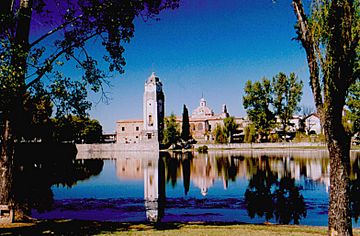Jesuit Block and Estancias of Córdoba facts for kids
| UNESCO World Heritage Site | |
|---|---|

View of the Estancia Alta Gracia
|
|
| Location | Córdoba Province, Argentina |
| Includes |
|
| Criteria | Cultural: (ii), (iv) |
| Inscription | 2000 (24th Session) |
| Area | 38.12 ha (94.2 acres) |
The Jesuit Block and Estancias of Córdoba are a group of old buildings and farms in Córdoba Province, Argentina. They were built by a religious group called the Jesuits. These amazing places were named a World Heritage Site in the year 2000. This means they are very important to the history and culture of the world.
Contents
What is the Jesuit Block?
The main part of this site is called the Manzana Jesuítica. This Spanish name means "Jesuit Block." It is located in the city of Córdoba. This block holds several important buildings.
- University of Córdoba: This is one of the oldest universities in all of South America. It has been teaching students for many centuries.
- Monserrat Secondary School: This is a high school that was also started by the Jesuits.
- A Church: A beautiful church is part of the block, used for religious services.
- Residence Buildings: These were homes for the Jesuits who lived and worked there.
Exploring the Jesuit Estancias
To help support their schools and churches, the Jesuits also ran six large farms. These farms are called Estancias. They were spread out around the Córdoba Province.
The names of these six Estancias are:
- Caroya
- Jesús María
- Santa Catalina
- Alta Gracia
- Candelaria
- San Ignacio
Each Estancia had its own church and other buildings. Small towns often grew up around these farms. For example, Alta Gracia is a town that grew near one of the Estancias. It is also the closest Estancia to the main Jesuit Block.
A Look at History
The Jesuits started building this large project in 1615. They worked on these farms and buildings for many years. However, in 1767, King Charles III of Spain made a big decision. He ordered all Jesuits to leave the continent. This event is known as the Suppression of the Jesuits.
After the Jesuits left, another religious group called the Franciscans took over. They managed the farms and buildings until 1853. That year, the Jesuits were allowed to return to The Americas. But the university and high school were taken over by the government a year later.
Visiting the Jesuit Sites
Today, you can visit the Jesuit Block and the Estancias. There is a special route called the Road of the Jesuit Estancias. This road is about 250 kilometres (160 mi) long. It connects all these historic sites. It's a great way to learn about the history of the Jesuits in Argentina.
Did you know that Pope Francis, who is the current leader of the Catholic Church, once lived here? His name was Jorge Mario Bergoglio before he became Pope.
See also
 In Spanish: Estancias jesuíticas para niños
In Spanish: Estancias jesuíticas para niños
- List of Jesuit sites

